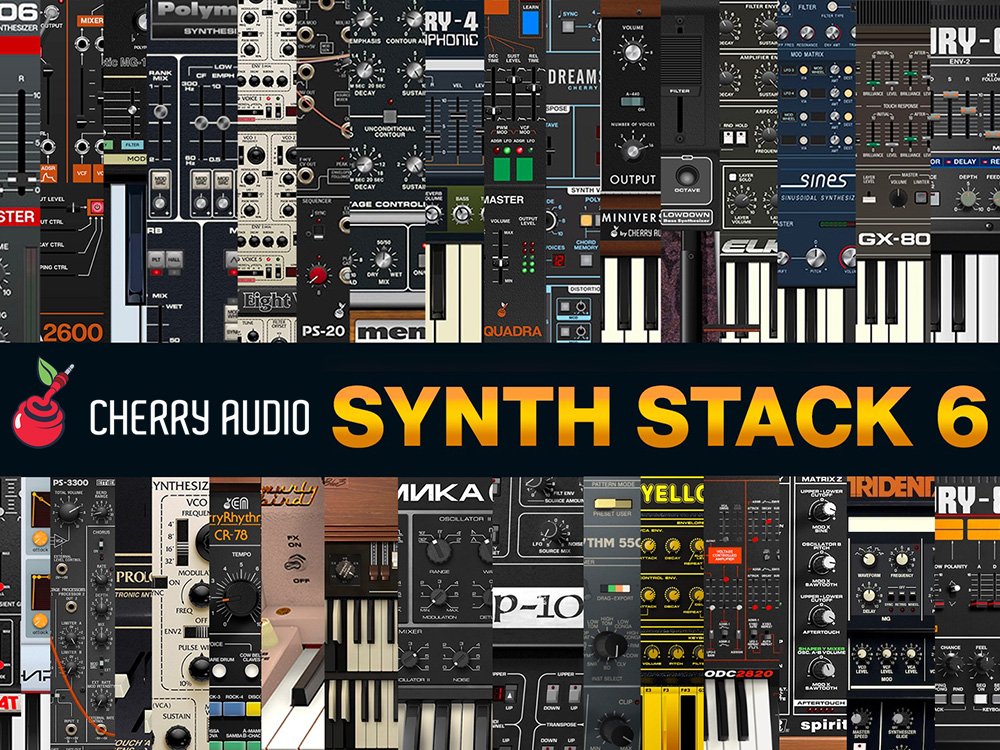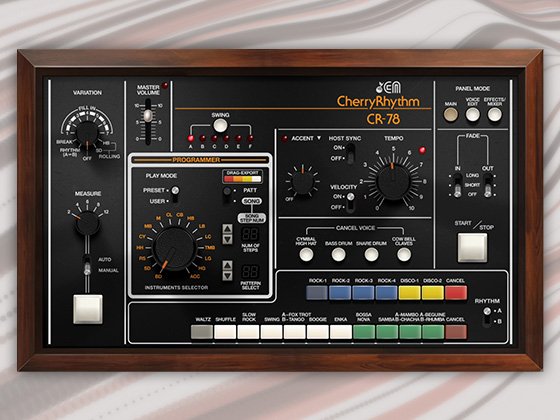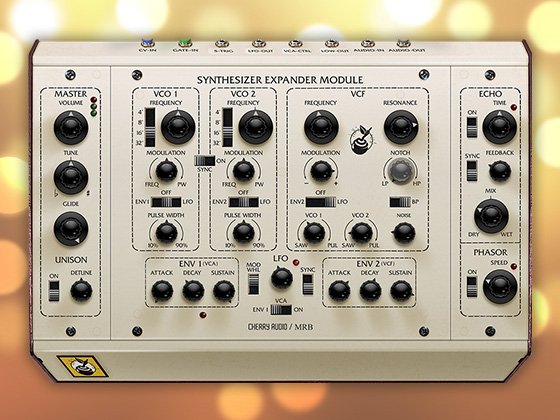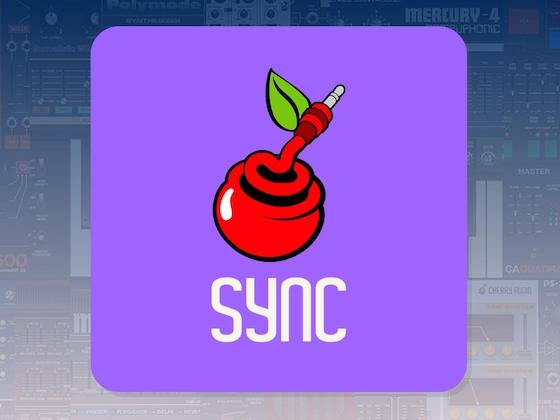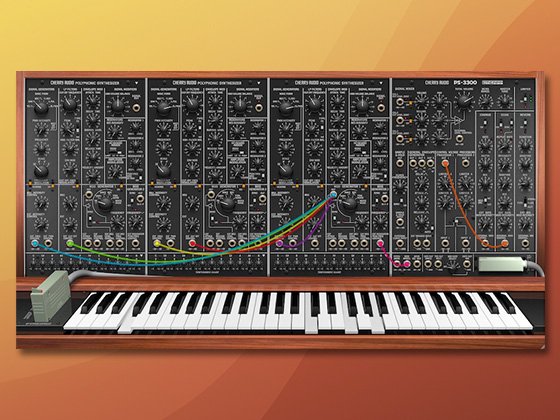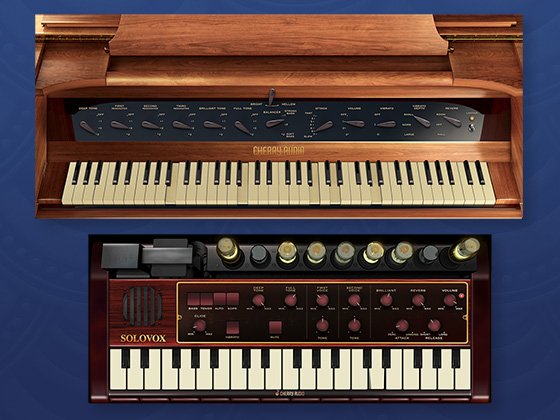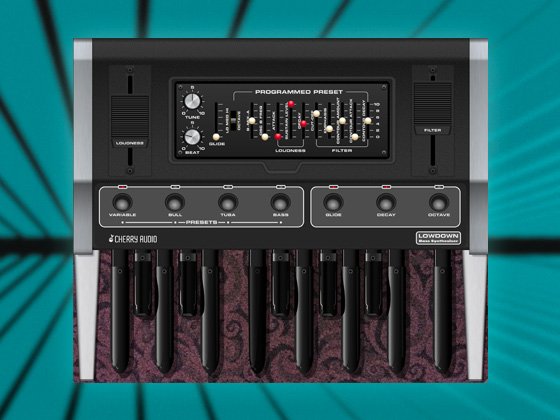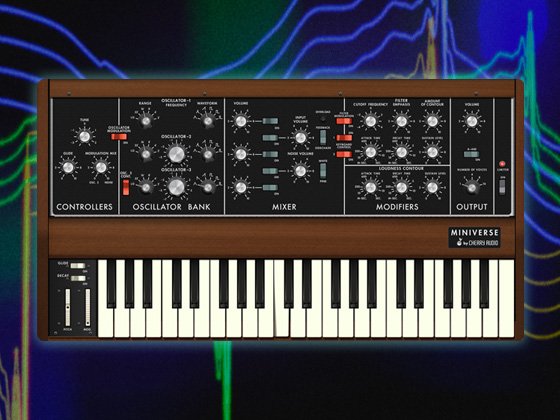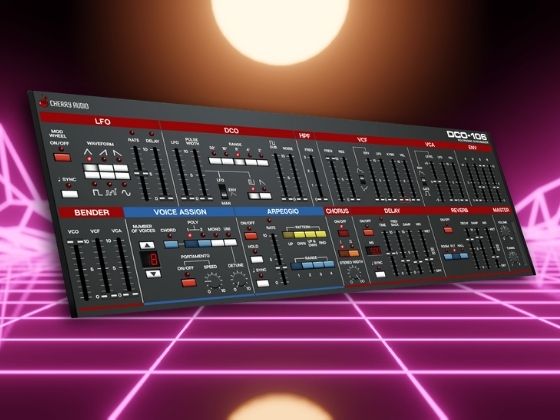Manufacturer: Weevil
$20.00
The SCW Oscillator is a stereo dual oscillator using static Single Cycle Waveforms as its base sound source, these are then modified in the time domain with up to four effects per oscillator and in the frequency domain with up to three spectral effects per oscillator.
OVERVIEW
The module consists of two identical oscillators: A and B. You switch between the oscillators with the A and B buttons at the top left corner of the module.
The octave knob (OCT), semitone knob (SEMI) and fine-tune knob (FINE) for oscillator A sets the main frequency of the module. The same controls for oscillator B sets the frequency offset for oscillator B. The phase difference between oscillator A and B can be set with the PHASE knob in oscillator A. Oscillator B instead has a HZ knob, this sets a linear frequency difference to allow for constant beating between the oscillators regardless of pitch.
You can change the oscillator to an LFO by turning the OCT knop of oscillator A all the way to the left. In LFO mode it ignores the pitch input signal and links the frequency to the BPM.
WAVEFORMS
Each oscillator has two waveforms: left and right. You set the mix between the left and the right waveform with the position knob (POS) in the lower left section of the module.
The waveform names are displayed at the top of the module above the waveform display and the effect knobs. To change a waveform click the triangle shaped button to the left of the waveform name (or click on the waveform name). Some options in the drop down needs further explanation:
- BASIC - the basic waveforms
- ADVENTUREKID - waveforms from adventure kid (more can be found here: https://www.adventurekid.se/akrt/waveforms/)
- R_WARE - waveforms from R_WARE
- LOAD SINGLE CYCLE WAVEFORM - this lets you load a single cycle waveform from your computer.
- SETTINGS
- INVERT - inverts the wave
- REVERSE - reverses the wave
- SPLINE REPEAT - make the wave smoother when using any repeat option
- 1 - resets repeat options
- 1 + 1 - repeats the wave according to the label
- 1 + 2 - repeats the wave according to the label
- 1 + 1 + 1 - repeats the wave according to the label
- etc...
- DELETE - deletes this waveform (only available if you have added more than one waveform)
- ADD WAVE - adds an additional waveform
The small arrows "<" and ">" to the right of the waveform name is a shortcut to change to the previous or next waveform, if you have a standard waveform it will pick from the standard waveform list, if you currently have loaded a single cycle waveform from your computer it will change to the next waveform in that folder.
EFFECTS
Each waveform can be modified with up to four (time-domain) effects. Each of the four effect slots has the following controls:
- L and R button to enable the effect for the left and right waveform.
- FX parameter 1 knob - the main control of the effect. Usually this sets the effect amount.
- FX parameter 2 knob - modifier amount for the effect.
- FX select button - sets the effect type.
- FX mod select button - sets the effect modifier.
Below you can find a list of the available effects and their respective modifiers :
- DISTORTION (DIST) - Light saturation to heavy distortion depending on knob position.
- OFFSET (OFFS) - offset the wave up or down.
- UP-DOWN (U-D) - change the vertical distribution to lean towards 5V or -5V.
- MID-EXTREMES (M-D) - change the vertical distribution to lean towards 0V or +/-5V.
- CLIPPING (CLP) - Knob amplifies the signal, signal clips at +/- 5V.
- OFFSET (OFFS) - offset the wave up or down.
- UP-DOWN (U-D) - change the vertical distribution to lean towards 5V or -5V.
- MID-EXTREMES (M-D) - change the vertical distribution to lean towards 0V or +/-5V.
- POWER (POW) - Power multiplies the signal with itself (this suppresses low values.) Knob sets the power factor.
- UP-DOWN (U-D) - change the vertical distribution to lean towards 5V or -5V.
- MID-EXTREMES (M-D) - change the vertical distribution to lean towards 0V or +/-5V.
- FOLD (FOLD) - Fold amplifies the signal based on the knob position and folds it back into itself above +/- 5V.
- OFFSET (OFFS) - offset the wave up or down.
- UP-DOWN (U-D) - change the vertical distribution to lean towards 5V or -5V.
- MID-EXTREMES (M-D) - change the vertical distribution to lean towards 0V or +/-5V.
- WIDTH (WIDTH) - Reshape the wave by moving the mid position of the wave (and expanding / contracting the left and right side). Knob sets the new mid position. The neutral knob position is 0.5 (most other FX are neutral at 0).
- ANCHOR (ANCHR) - sets the start mid position (the position that is modified by the width knob).
- WIDTH (SOFT) (WSFT) - Similar to Width but with a soft curve instead of a linear curve.
- ANCHOR (ANCHR) - sets the start mid position (the position that is modified by the width knob).
- SYNC (SYNC) - Repeats the wave (similar to hard sync in a normal oscillator). Knob set the number of repetitions.
- LEFT-RIGHT (L-R) - change the horizontal distribution to lean towards the left or the right side.
- MID-SIDES (M-S) - change the horizontal distribution to lean towards the mid or the sides.
- SYNC (WINDOW) (SYNW) - Similar to sync with an added sync window to smooth the edges at the start and end of the waveform.
- LEFT-RIGHT (L-R) - change the horizontal distribution to lean towards the left or the right side.
- MID-SIDES (M-S) - change the horizontal distribution to lean towards the mid or the sides.
- PADDING (PAD) - Add padding (0V) at the start and end of the waveform. Knob sets the amount of padding.
- ANCHOR (ANCHR) - sets the start mid position of the wave.
- PAUSE (PAUS) - Extends the midpoint of the wave (and contracts the left and right side of the midpoint). Knob set the amount of extension.
- ANCHOR (ANCHR) - sets the pause-position.
- SAMPLE AND HOLD (S&H) - Change resolution of the wave by freezing (sample and hold) the value at a certain frequency. Knob sets the frequency.
- LEFT-RIGHT (L-R) - change the horizontal distribution to lean towards the left or the right side.
- MID-SIDES (M-S) - change the horizontal distribution to lean towards the mid or the sides.
- SAMPLE AND LINE (S&LN) - Linear interpolation (non-curved lines) between points at a certain frequency. Knob sets the frequency.
- LEFT-RIGHT (L-R) - change the horizontal distribution to lean towards the left or the right side.
- MID-SIDES (M-S) - change the horizontal distribution to lean towards the mid or the sides.
- SAMPLE AND SPLINE (S&S) - Spline interpolation (curved lines) between points at a certain frequency. Knob sets the frequency.
- LEFT-RIGHT (L-R) - change the horizontal distribution to lean towards the left or the right side.
- MID-SIDES (M-S) - change the horizontal distribution to lean towards the mid or the sides.
- TRACK AND Hold (T&H) - Alter between sample and hold and normal wave at a certain frequency. Knob sets the frequency.
- LEFT-RIGHT (L-R) - change the horizontal distribution to lean towards the left or the right side.
- MID-SIDES (M-S) - change the horizontal distribution to lean towards the mid or the sides.
- TRACK AND LINE (T&LN) - Alter between linear interpolation and normal wave at a certain frequency. Knob sets the frequency.
- LEFT-RIGHT (L-R) - change the horizontal distribution to lean towards the left or the right side.
- MID-SIDES (M-S) - change the horizontal distribution to lean towards the mid or the sides.
- TRACK AND LINE (SPLINE) (T&S) - Alter between spline interpolation and normal wave at a certain frequency. Knob sets the frequency.
- LEFT-RIGHT (L-R) - change the horizontal distribution to lean towards the left or the right side.
- MID-SIDES (M-S) - change the horizontal distribution to lean towards the mid or the sides.
- TRACK AND REVERSE (T&R) - Alter between reversing the last section of the wave and normal wave at a certain frequency. Knob sets the frequency.
- LEFT-RIGHT (L-R) - change the horizontal distribution to lean towards the left or the right side.
- MID-SIDES (M-S) - change the horizontal distribution to lean towards the mid or the sides.
- TRACK AND ZERO (T&Z) - Alter between 0V and normal wave at a certain frequency. Knob sets the frequency.
- LEFT-RIGHT (L-R) - change the horizontal distribution to lean towards the left or the right side.
- MID-SIDES (M-S) - change the horizontal distribution to lean towards the mid or the sides.
- TRACK AND ZERO (SPLINE) (T&Z) - Alter between 0V and normal wave at a certain frequency (spline interpolation to the 0 value). Knob sets the frequency.
- LEFT-RIGHT (L-R) - change the horizontal distribution to lean towards the left or the right side.
- MID-SIDES (M-S) - change the horizontal distribution to lean towards the mid or the sides.
- TRACK AND MIX (PRE-FX) (T&M) - Alter between the waveform of the opposite oscillator (pre-fx) and normal wave at a certain frequency. Knob sets the frequency.
- LEFT-RIGHT (L-R) - change the horizontal distribution to lean towards the left or the right side.
- MID-SIDES (M-S) - change the horizontal distribution to lean towards the mid or the sides.
- TRACK AND MIX (POST-FX) (T&MP) - Alter between the waveform of the opposite oscillator (post-fx) and normal wave at a certain frequency. Knob sets the frequency.
- LEFT-RIGHT (L-R) - change the horizontal distribution to lean towards the left or the right side.
- MID-SIDES (M-S) - change the horizontal distribution to lean towards the mid or the sides.
- PHASE AVERAGE (PAVG) - Phase offsets a copy of the waveform and mix that with the waveform itself. Knob sets the phase offset.
- LEFT-RIGHT (L-R) - change the horizontal distribution to lean towards the left or the right side.
- MID-SIDES (M-S) - change the horizontal distribution to lean towards the mid or the sides.
- UP-DOWN (U-D) - change the vertical distribution to lean towards 5V or -5V.
- MID-EXTREMES (M-D) - change the vertical distribution to lean towards 0V or +/-5V.
- FACTOR (FACT) - above 0.5 it applies "integer"-syncing to one of the waves (whole copies of the wave are added), below 0.5 it adds windowed syncing to one of the waves.
- PHASE MINIMUM (PMIN) - Phase offsets a copy of the waveform, output is the min value (range -5 to 5V) of the waveform and the offset waveform. Knob sets the phase offset.
- LEFT-RIGHT (L-R) - change the horizontal distribution to lean towards the left or the right side.
- MID-SIDES (M-S) - change the horizontal distribution to lean towards the mid or the sides.
- UP-DOWN (U-D) - change the vertical distribution to lean towards 5V or -5V.
- MID-EXTREMES (M-D) - change the vertical distribution to lean towards 0V or +/-5V.
- FACTOR (FACT) - above 0.5 it applies "integer"-syncing to one of the waves (whole copies of the wave are added), below 0.5 it adds windowed syncing to one of the waves.
- PHASE MAXIMUM (PMAX) - Phase offsets a copy of the waveform, output is the max value (range -5 to 5V) of the waveform and the offset waveform. Knob sets the phase offset.
- LEFT-RIGHT (L-R) - change the horizontal distribution to lean towards the left or the right side.
- MID-SIDES (M-S) - change the horizontal distribution to lean towards the mid or the sides.
- UP-DOWN (U-D) - change the vertical distribution to lean towards 5V or -5V.
- MID-EXTREMES (M-D) - change the vertical distribution to lean towards 0V or +/-5V.
- FACTOR (FACT) - above 0.5 it applies "integer"-syncing to one of the waves (whole copies of the wave are added), below 0.5 it adds windowed syncing to one of the waves.
- PHASE MINIMUM BOUNDED (PMIB) - Phase offsets a copy of the waveform, output is the abs min value (range 0 to 5V) of the waveform and the offset waveform. Knob sets the phase offset.
- LEFT-RIGHT (L-R) - change the horizontal distribution to lean towards the left or the right side.
- MID-SIDES (M-S) - change the horizontal distribution to lean towards the mid or the sides.
- UP-DOWN (U-D) - change the vertical distribution to lean towards 5V or -5V.
- MID-EXTREMES (M-D) - change the vertical distribution to lean towards 0V or +/-5V.
- FACTOR (FACT) - above 0.5 it applies "integer"-syncing to one of the waves (whole copies of the wave are added), below 0.5 it adds windowed syncing to one of the waves.
- PHASE MAXIMUM BOUNDED (PMAB) - Phase offsets a copy of the waveform, output is the abs max value (range 0 to 5V) of the waveform and the offset waveform. Knob sets the phase offset.
- LEFT-RIGHT (L-R) - change the horizontal distribution to lean towards the left or the right side.
- MID-SIDES (M-S) - change the horizontal distribution to lean towards the mid or the sides.
- UP-DOWN (U-D) - change the vertical distribution to lean towards 5V or -5V.
- MID-EXTREMES (M-D) - change the vertical distribution to lean towards 0V or +/-5V.
- FACTOR (FACT) - above 0.5 it applies "integer"-syncing to one of the waves (whole copies of the wave are added), below 0.5 it adds windowed syncing to one of the waves.
- PHASE MODULATION (SINE) (FM1) - Phase modulates (FM) the wave with a sine wave. Knob set fm amount.
- FACTOR (FACT) - above 0.5 it applies "integer"-syncing to the modulation wave (whole copies of the wave are added), below 0.5 it adds integer syncing to the source wave.
- FACTOR WINDOW (FCWN) - above 0.5 it applies windowed syncing to the modulation wave (whole copies of the wave are added), below 0.5 it adds windowed syncing to the source wave.
- PHASE MODULATION (SELF) (FM2) - Phase modulates (FM) the wave with itself. Knob set fm amount.
- FACTOR (FACT) - above 0.5 it applies "integer"-syncing to the modulation wave (whole copies of the wave are added), below 0.5 it adds integer syncing to the source wave.
- FACTOR WINDOW (FCWN) - above 0.5 it applies windowed syncing to the modulation wave (whole copies of the wave are added), below 0.5 it adds windowed syncing to the source wave.
- PHASE MODULATION (OTHER OSCILLATOR PRE-FX) (FM3) - Phase modulates (FM) the wave from the opposite oscillator (pre-fx). Knob sets the fm amount.
- FACTOR (FACT) - above 0.5 it applies "integer"-syncing to the modulation wave (whole copies of the wave are added), below 0.5 it adds integer syncing to the source wave.
- FACTOR WINDOW (FCWN) - above 0.5 it applies windowed syncing to the modulation wave (whole copies of the wave are added), below 0.5 it adds windowed syncing to the source wave.
- PHASE MODULATION (OTHER OSCILLATOR POST-FX) (FM4) - Phase modulates (FM) the wave from the opposite oscillator (post-fx). Knob sets the fm amount.
- FACTOR (FACT) - above 0.5 it applies "integer"-syncing to the modulation wave (whole copies of the wave are added), below 0.5 it adds integer syncing to the source wave.
- FACTOR WINDOW (FCWN) - above 0.5 it applies windowed syncing to the modulation wave (whole copies of the wave are added), below 0.5 it adds windowed syncing to the source wave.
- RING MODULATION (OTHER OSCILLATOR POST-FX) (RMN1) - Ring modulates the wave with the opposite oscillator (post-fx). Knob sets the rm amount.
- FACTOR (FACT) - above 0.5 it applies "integer"-syncing to the modulation wave (whole copies of the wave are added), below 0.5 it adds integer syncing to the source wave.
- FACTOR WINDOW (FCWN) - above 0.5 it applies windowed syncing to the modulation wave (whole copies of the wave are added), below 0.5 it adds windowed syncing to the source wave.
- SATURATION (SAT) - above 0.5 adds saturation to the modulation wave, below 0.5 adds saturation to the source wave.
- AMPLITUDE MODULATION (OTHER OSCILLATOR POST-FX RECTIFIED) (AM1) - Amplitude modulates the wave with absolute value of the opposite oscillator (post-fx). Knob sets the am amount.
- FACTOR (FACT) - above 0.5 it applies "integer"-syncing to the modulation wave (whole copies of the wave are added), below 0.5 it adds integer syncing to the source wave.
- FACTOR WINDOW (FCWN) - above 0.5 it applies windowed syncing to the modulation wave (whole copies of the wave are added), below 0.5 it adds windowed syncing to the source wave.
- SATURATION (SAT) - above 0.5 adds saturation to the modulation wave, below 0.5 adds saturation to the source wave.
- AMPLITUDE MODULATION (OTHER OSCILLATOR POST-FX OFFSET) (AM2) - Amplitude modulates the wave with value of the opposite oscillator converted to the range 0 to 1 (post-fx). Knob sets the am amount.
- FACTOR (FACT) - above 0.5 it applies "integer"-syncing to the modulation wave (whole copies of the wave are added), below 0.5 it adds integer syncing to the source wave.
- FACTOR WINDOW (FCWN) - above 0.5 it applies windowed syncing to the modulation wave (whole copies of the wave are added), below 0.5 it adds windowed syncing to the source wave.
- SATURATION (SAT) - above 0.5 adds saturation to the modulation wave, below 0.5 adds saturation to the source wave.
- BITCRUSHING (BIT) - Reduce bit range. Knob sets the bit reduction.
- UP-DOWN (U-D) - apply more bit crushing on the upper part of the wave or the lower part of the wave.
- MID-EXTREMES (M-D) - apply more bit crushing on low values (0V) or high values (+/-5V).
- BITWISE AND (CONSTANT) (AND1) - Reduce bit range. Apply binary AND comparison with constant value. Knob sets the bit reduction.
- CONSTANT (CONST) - sets the constant value.
- BITWISE AND (OTHER OSCILLATOR POST-FX) (AND2) - Reduce bit range. Apply binary AND comparison with the opposite oscillator (post-fx). Knob sets the bit reduction.
- PHASE (PHAS) - sets the phase of the opposite oscillator.
- BITWISE OR (CONSTANT) (OR1) - Reduce bit range. Apply binary OR comparison with constant value. Knob sets the bit reduction.
- CONSTANT (CONST) - sets the constant value.
- BITWISE OR (OTHER OSCILLATOR POST-Fx) (OR2) - Reduce bit range. Apply binary OR comparison with the opposite oscillator (post-fx). Knob sets the bit reduction.
- PHASE (PHAS) - sets the phase of the opposite oscillator.
- BITWISE XOR (CONSTANT) (XOR1) - Reduce bit range. Apply binary XOR comparison with constant value. Knob sets the bit reduction.
- CONSTANT (CONST) - sets the constant value.
- BITWISE XOR (OTHER OSCILLATOR POST-FX) (XOR2) - Reduce bit range. Apply binary XOR comparison with the opposite oscillator (post-fx). Knob sets the bit reduction.
- PHASE (PHAS) - sets the phase of the opposite oscillator.
- PHASE (PHASE) - Phase offset. Knob sets phase offset.
SPECTRAL EFFECTS
After the effects are applied the left and right waveform are mixed (POS), see general oscillator settings section below. The output of this is sent to the three spectral effects. The spectral effects work in the frequency domain and modify the amount of the individual overtone bands of the waveform.
The SFX knob and button lets you change the routing of the spectral effects. The available options are:
- SERIAL (SRL) - the filters are serially connected. With the knob at its mid, you get the output from SFX3, you can mix in SFX1 by turning the knob left and mix in SFX 2 by turning the knob right.
- PARALLEL (PRL) - the filters are connected in parallel. Turning the knob left will emphasize SFX 1, turning it right will emphasize SFX 3. All three filters are used unless the knobs are at its extremes.
- ONE TO TWO (1-2) - filter 1 is connected to filter 2 and filter 3. The knob sets the mix between filter 2 and 3.
- TWO TO ONE (2-1) - filter 1 and 2 are connected to filter 3. The knob sets the mix between filter 1 and 2.
- MIX - the filters are connected in parallel. The knob shifts the mix from filter 1 to filter 2 to filter 3. Only to filters used at the same time.
Available spectral effects:
- SHIFT UP - shift frequency bands up by between 0 and 15 (band step size 2, even to even, odd to odd).
- UP - sets the upward shift.
- MIX - sets the mix between original wave and shifted wave.
- SHIFT DOWN - shift frequency bands down by between 0 and 15 (band step size 2, even to even, odd to odd).
- DOWN - sets the downward shift.
- MIX - sets the mix between original wave and shifted wave.
- SHIFT UP X - shift frequency bands up by between 0 and 16 (variable shift size).
- UP - sets the upward shift.
- STEP - sets the step length between 1 and 4.
- MIX - sets the mix between original wave and shifted wave.
- SHIFT DOWN X - shift frequency bands up by between 0 and 16 (variable shift size).
- DOWN - sets the downward shift.
- STEP - sets the step length between 1 and 4.
- MIX - sets the mix between original wave and shifted wave.
- PARITY EVEN / ODD - shift parity between even and odd bands.
- PARITY - sets parity between even and odd harmonies.
- PARITY CONTINUOUS - shift parity between two parameter defined bands (continuous).
- PARITY - sets parity between the first band divider (BAND) and the second band divider (MOD).
- BAND - sets the first band divider (stepped).
- MOD - sets the second band divider (stepped).
- MIX - sets the mix between the original wave and the post effect wave.
- PARITY STEPPED - shift parity between two parameter defined bands (stepped).
- PARITY - sets parity between the first band divider (BAND) and the second band divider (MOD).
- BAND - sets the first band divider (continuous).
- MOD - sets the second band divider (continuous).
- MIX - sets the mix between the original wave and the post effect wave.
- PARITY EXPONENTIAL - shift parity of an exponential set of bands and the same wave without those bands (stepped).
- PARITY - sets parity between exponential bands and the wave without those bands.
- BASE - sets the exponential base between 1 and 4.
- MOD - sets an offset to each exponential band (offset between itself and the next exponential value).
- OCTAVES - with base setting this adds additional octaves of the original wave.
- POWER - sets pitch of the added octaves.
- BASE - sets base to the power value in the previous parameter (0 is no octave shift, 0.5 is one octave shift, 1 is double octave shift). Values in between will give you something in between.
- WIDTH - sets the width of octaves added (basically a width to the POWER parameter).
- MIX - sets the mix between the original wave and the post effect wave.
- TILT - tilt wave towards upper or lower frequency bands.
- CENTER - sets the center frequency (tilt sets the balance between below and above this frequency).
- CURVE - sets how steep the balance curve is.
- TILT - sets the tilt amount (balance between above and below the center frequency).
- FORMANT - format filter.
- FORMANT - sets the formant vowel.
- SLOPE - set the slope of the filter.
- SPREAD - sets the frequency for the formant.
- AMOUNT - sets balance between formant frequencies and all frequencies.
- LOW PASS - low pass filter.
- CUTOFF - sets the cutoff frequency.
- SLOPE - sets the filter slope (from low pole to high poles).
- RES - sets the filter resonance.
- TILT - sets the slope balance (low value gives a lower slope for frequencies below the cutoff and higher slope above the cutoff, high value gives the opposite).
- LOW PASS (DUAL PEAK) - low pass filter with dual resonance peaks.
- CUTOFF - sets the cutoff frequency.
- SLOPE - sets the filter slope (from low pole to high poles).
- RES - sets the filter resonance.
- DSTNC - sets the distance between the two filter peaks.
- HIGH PASS - high pass filter.
- CUTOFF - sets the cutoff frequency.
- SLOPE - sets the filter slope (from low pole to high poles).
- RES - sets the filter resonance.
- TILT - sets the slope balance (low value gives a lower slope for frequencies below the cutoff and higher slope above the cutoff, high value gives the opposite).
- HIGH PASS (DUAL PEAK) - high pass filter with dual resonance peaks.
- CUTOFF - sets the cutoff frequency.
- SLOPE - sets the filter slope (from low pole to high poles).
- RES - sets the filter resonance.
- DSTNC - sets the distance between the two filter peaks.
- BAND PASS - band pass filter.
- CUTOFF - sets the cutoff frequency.
- SLOPE - sets the filter slope (from low pole to high poles).
- RES - sets the filter resonance.
- TILT - sets the slope balance (low value gives a lower slope for frequencies below the cutoff and higher slope above the cutoff, high value gives the opposite).
- DUAL BAND PASS - dual band pass filter.
- CUTOFF - sets the cutoff frequency.
- SLOPE - sets the filter slope (from low pole to high poles).
- DSTNC - sets the distance between the two filter peaks.
- FACTOR - sets the balance between the two filter peaks.
- NOISE - add noise to some (or all) frequency bands.
- FREQ - sets the center frequency.
- WIDTH - sets the width around the center frequency.
- AMP - sets the strength of the noise
- SPEED - sets how fast the band offsets are changed (for high values you will need a low number for the calculation steps, you set this with the button above the PHASE output).
- MERGE - merge the wave of this oscillator on the spectral level with the wave of the opposite oscillator.
- FREQ - sets the center frequency.
- WIDTH - sets the width around the center frequency.
- TILT - sets the width balance between low and high frequencies.
- AMOUNT - sets how much the opposite wave affects the wave.
GENERAL OSCILLATOR SETTINGS
Below the spectral filters you find the general oscillator level effects.
The position knob (POS) sets the mix between the left and the right waveform. The button below lets you set the mix type, the available options are:
- AVERAGE (AVG) - normal mix.
- HIGH - start by mixing in the high frequencies from the right wave.
- LOW - start by mixing in low frequencies from the right wave.
- EVEN - start by mixing in even bands from the right wave (up to 0.5), then odd bands (up to 1).
- ODD - start by mixing in odd bands from the right wave (up to 0.5), then even bands (up to 1).
- MAX - at 0.5 it controls the strongest band from both waves. 0 to 0.5 mix from left wave to the strongest bands, 0.5 to 1 mix from strongest bands to right wave.
- MIN - at 0.5 it controls the weakest band from both waves. 0 to 0.5 mix from left wave to the weakest bands, 0.5 to 1 mix from weakest bands to right wave.
Unison (UNISON) lets you stack multiple voices of the oscillator with a moving phase offset per voice. The knob sets how fast the phase offset changes, the button lets you set voice count and phase offset type.
CV
The module has 8 assignable CV inputs. Most CV targets are control rate (see Update Frequency), not audio rate, if audio rate is supported this is marked with AUDIO RATE.
Each assignable CV group consists of a CV target (you change CV target with the triangle button next to the target name), an input and an attenuverter (-1 to 1). The available CV targets are:
- SPECTRAL EFFECT OSCILLATOR A
- OSCILLATOR A SFX 1 PARAMETER 1 (ASFX1P1)
- OSCILLATOR A SFX 1 PARAMETER 2 (ASFX1P2)
- OSCILLATOR A SFX 1 PARAMETER 3 (ASFX1P3)
- OSCILLATOR A SFX 1 PARAMETER 4 (ASFX1P4)
- OSCILLATOR A SFX 2 PARAMETER 1 (ASFX2P1)
- OSCILLATOR A SFX 2 PARAMETER 2 (ASFX2P2)
- OSCILLATOR A SFX 2 PARAMETER 3 (ASFX2P3)
- OSCILLATOR A SFX 2 PARAMETER 4 (ASFX2P4)
- OSCILLATOR A SFX 3 PARAMETER 1 (ASFX3P1)
- OSCILLATOR A SFX 3 PARAMETER 2 (ASFX3P2)
- OSCILLATOR A SFX 3 PARAMETER 3 (ASFX3P3)
- OSCILLATOR A SFX 3 PARAMETER 4 (ASFX3P4)
- SPECTRAL EFFECT OSCILLATOR B
- OSCILLATOR B SFX 1 PARAMETER 1 (BSFX1P1)
- OSCILLATOR B SFX 1 PARAMETER 2 (BSFX1P2)
- OSCILLATOR B SFX 1 PARAMETER 3 (BSFX1P3)
- OSCILLATOR B SFX 1 PARAMETER 4 (BSFX1P4)
- OSCILLATOR B SFX 2 PARAMETER 1 (BSFX2P1)
- OSCILLATOR B SFX 2 PARAMETER 2 (BSFX2P2)
- OSCILLATOR B SFX 2 PARAMETER 3 (BSFX2P3)
- OSCILLATOR B SFX 2 PARAMETER 4 (BSFX2P4)
- OSCILLATOR B SFX 3 PARAMETER 1 (BSFX3P1)
- OSCILLATOR B SFX 3 PARAMETER 2 (BSFX3P2)
- OSCILLATOR B SFX 3 PARAMETER 3 (BSFX3P3)
- OSCILLATOR B SFX 3 PARAMETER 4 (BSFX3P4)
- EFFECT OSCILLATOR A
- OSCILLATOR A FX 1 (AFX1)
- OSCILLATOR A FX 1 MOD (AFX1M)
- OSCILLATOR A FX 2 (AFX2)
- OSCILLATOR A FX 2 MOD (AFX2M)
- OSCILLATOR A FX 3 (AFX3)
- OSCILLATOR A FX 3 MOD (AFX3M)
- OSCILLATOR A FX 4 (AFX4)
- OSCILLATOR A FX 4 MOD (AFX4M)
- EFFECT OSCILLATOR B
- OSCILLATOR B FX 1 (BFX1)
- OSCILLATOR B FX 2 MOD (BFX1M)
- OSCILLATOR B FX 2 (BFX2)
- OSCILLATOR B FX 2 MOD (BFX2M)
- OSCILLATOR B FX 3 (BFX3)
- OSCILLATOR B FX 3 MOD (BFX3M)
- OSCILLATOR B FX 4 (BFX4)
- OSCILLATOR B FX 4 MOD (BFX4M)
- GENERAL OSCILLATOR A
- OSCILLATOR A POSITION (APOS)
- OSCILLATOR A UNISON (AUNI) - AUDIO RATE
- OSCILLATOR A SFX POS (ASFXPOS)
- OSCILLATOR A PITCH OFFSET (AUNI) - AUDIO RATE
- GENERAL OSCILLATOR B
- OSCILLATOR B POSITION (BPOS)
- OSCILLATOR B UNISON (BUNI) - AUDIO RATE
- OSCILLATOR B SFX POS (BSFXPOS)
- OSCILLATOR B PITCH OFFSET (BUNI) - AUDIO RATE
- GENERAL SHARED
- MIX (MIX) - AUDIO RATE
- STEREO (STEREO) - AUDIO RATE
- SUB AMOUNT (SUB) - AUDIO RATE
- MOD AMOUNT (MOD) - AUDIO RATE
GENERAL MODULE SETTINGS
Waveform Length - Above the V/CV input a button lets you change the waveform length (default is 2048). Longer waveform length allows for more overtones, this changes the range of the spectral effects since they always work over the range of available overtones. If you are using spectral effects, try different waveform lengths, it can drastically change the sound.
Update Frequency - The button right of this sets the update frequency. This sets how often the module recalculates the waveform, if you need fast CV for effects and spectral effects you should set this to a low number.
The SAVE button lets you save the waveform of the selected oscillator (use this to create your own library of single cycle waveforms).
The MIX knob sets the mix between oscillator A and B. With the button below you can change to individual outs for oscillator A and B.
STEREO AMOUNT knob - sets the stereo amount.
STEREO MODE button - sets the stereo mode, the available options are:
- NONE - no stereo
- PHASE - adds a phase offset of up to 180 degrees between the left and right channels.
- MIX - adds a mix offset (between oscillator A and B) of up to 50% between the left and right channels.
SUB AMOUNT - sets the mix between sub oscillator and MOD output.
SUB MODE - settings for the sub oscillator. The available options are:
- NONE - no sub oscillator
- A - sub oscillator uses the wave from oscillator A
- B - sub oscillator uses the wave from oscillator B
- MIX - sub oscillator uses the mix wave
- INVERSE - toggles between normal wave and inverse wave
- REVERSE - toggles between normal wave and reverse wave
- -1 - sub oscillator is 1 octave below oscillator A
- -2 - sub oscillator is 2 octaves below oscillator A
- -3 - sub oscillator is 3 octaves below oscillator A
MOD AMOUNT - sets the mix between mod output and oscillator output.
MOD MODE - Available options:
- RING MODULATION - ring modulation, multiply oscillator A with oscillator B
- SATURATED RING MODULATION - ring modulation with saturation applied to the two signals.
- AMPLITUDE MODULATION (RECTIFIED) - multiplies multiply oscillator A with the absolute value of oscillator B.
- AMPLITUDE MODULATION (OFFSET) - multiplies multiply oscillator A with the magnitude of oscillator B.
- MAX AMPLITUDE - takes the absolute max value of oscillator A and B
- MIN AMPLITUDE - takes the absolute min value of oscillator A and B
OUTPUT
- PHS - phase out, can be used to sync other oscillators or to sync an oscilloscope
- L - left audio out
- R - right audio out
If you have questions or suggestions, please reach out using the "Contact Manufacturer" link above.
